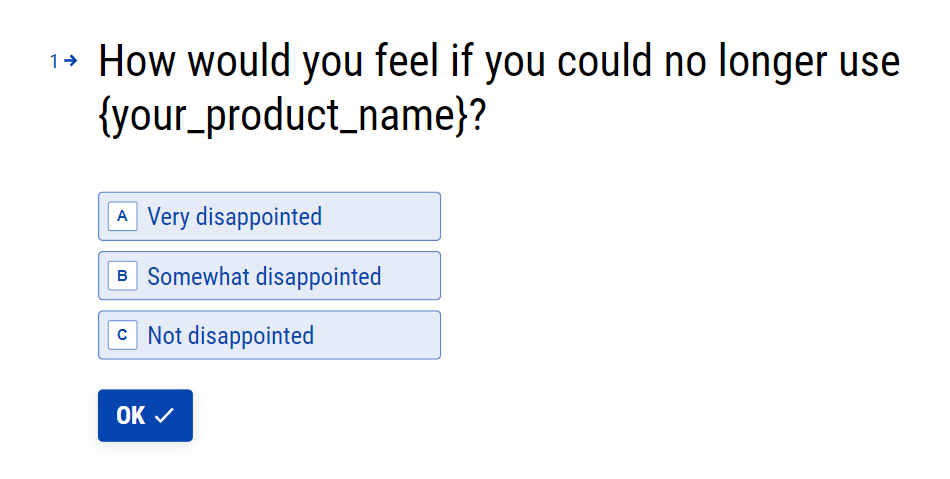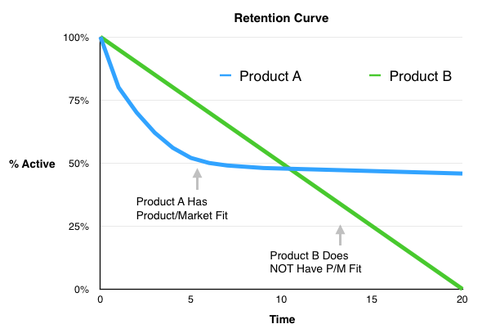“It seems like [insert your startup name here] is doing well, but does it have a PMF?”
This is what an investor, co-founder, or any other key stakeholder might ask you at some point and—in order to give them a proper answer—you will need to conduct a product-market fit analysis.
As a senior product manager, I have a playbook for this precise situation, and I'm sharing it with you now to help you test your product for a PMF and get a clear answer to this crucial question.
Why Measure Product-Market Fit?
Product-market fit means that your product has fulfilled underserved customer needs in the market and there are people who are using it on a regular basis and paying for it.
Although you can technically exist as a software company without achieving a PMF, you are doomed to fail eventually, as not having a PMF means that you are not able to solve any real user pains and your customers will soon let you go.
For startups, product-market fit is also a critical indicator for attracting new funding and keeping existing investors happy.
Therefore, it is critical for any product to strive for and achieve a PMF. But before getting to manage your PMF, there are several “preconditions” that your product needs to meet first.
Making Sure That Your Product Is Ready For Measuring Product Market Fit
One of the common mistakes that many product teams make is trying to achieve a PMF with aggressive acquisition before their product is ready to conquer the market.
Each product manager has their own criteria for a PMF-ready product. Mine is quite a simple one and consists of only two points.
Do You Have a Clear Value Proposition for Your Target Customers?
It is early for you to think about fulfilling the market need if you are still figuring out your value proposition.
The main value proposition of your product would be the promise of solving a problem or covering an underserved need for your potential customers.
To understand the need you want to solve, you will need to have a deep understanding of the people who are experiencing it as well as the environment where these problems appear. If you define your problem without this knowledge, you take the risk of misunderstanding what your users really need and building something that is not able to remedy their pain points.
Imagine that you are in the early 2000s and you hear some office workers complaining that collaborating on an offline document is inconvenient as they end up with a long email chain with a million versions of the same document.
Eureka! What if you build a product that stores documents in the cloud and lets them work on the same document collaboratively (a.k.a. Google Docs)?
This might look like the obvious solution here. But, if you do a series of discovery interviews with these office workers, you might find out that the content of this offline document is a list of action items and tasks for their team.

With this insight, you understand that the problem they face is not about document versioning, but about easy communication of task statuses. Therefore, you might solve their pains better if you build a collaborative task management tool (e.g. Trello) instead of an online document editor.

With this insight in mind, you can develop a product that has a compelling value proposition for your target customers. In this case, your value prop would be helping these office workers organize their tasks, collaborate on them with ease, and avoid miscommunications inside the team.
If you do have a clear value prop, you can move on to the second factor to get right before measuring your PMF—your product scope.
Do You Have A Minimum Viable Product (MVP) Ready?
You cannot really understand if the market has accepted your product if your product does not exist yet.
You all probably know what the MVP is, so there is no need to explain it here. Instead, I want to talk a bit about the features that go into the MVP and how to prioritize them.
The mindset I love to follow when defining the MVP scope is that of Eric Ries (the PM behind The Lean Startup). He defines MVP like this:
The minimum viable product is that version of a new product which allows a team to collect the maximum amount of validated learning about customers with the least effort.
-eric ries, the lean startup
It means that you want to prioritize all the features and functionality that help you validate your key hypotheses and exclude the rest.
From my experience, this is what you include in the scope:
Core feature(s): This refers to the single feature, or a feature set, that covers your main use case, shows your value proposition, and solves the main pain point for your users (e.g. finding and streaming songs for Spotify or sending and receiving emails for Gmail).
Don’t worry about your product looking too basic and “poor” in features. From my experience, these core features follow the 80/20 rule and represent 80% of the value that your users get from your product. Therefore, having only them in your MVP is usually more than enough to get people to use your product and pay for it.
Experience Blockers: These are the basic features that, should they not exist, would completely break the experience of your users and lead them to abandon your product, even if you were able to solve their problems.
An example of such a feature is undo/redo in Google Docs—would you ever use a document editing tool that did not allow you to undo your mistakes?
Analytics and Tracking: The purpose of your MVP is to gather insights and learn from them. So, it is crucial for you to set up an analytics tool for your product and track the key actions that your users take in your product. You can start with tracking the traction of your core features and building a usage dashboard for it (including a retention curve, stickiness chart, and DAU/WAU indicators).
Now that you have a solid value proposition for your customers and an MVP to test it, you can confidently take your product to the market and measure its PMF.
How To Tell if You Have Achieved a Product Market Fit
The definition of PMF is fairly vague and it would be natural for you to wonder how could one even measure the “market adopting your product."
PMF is ambiguous, I agree, but there are still several metrics and indicators that you can use as signs of achieving a product-market fit.
Here are five of these quantitative indicators that you can consider.
The Customers You Acquire (And Retain) Are Earning You a Profit
Obvious, right? You are a business after all. However, there is a big difference between your company being cash-positive and your customers being profitable.
The first one represents the difference between your total company costs and revenue in a given time period (usually a month). The second one, on the other hand, is the difference between the lifetime value (LTV) of your customer and its acquisition cost (CAC).
It's okay for a startup to be cash-negative (in fact, there is a separate PMF indicator involving this metric that we will talk about next) as it can be a sign that you are heavily investing in growth.
However, it is not a good sign if you spend more money bringing your customers in than you are planning to earn from them throughout their lifetime.
Yes, you might have a great marketing strategy in place. It might include a well-identified target market, and a proper understanding of the market share you plan to acquire. You might even have your buyer persona and demographics defined based on market research and your marketing channels like WOM (word-of-mouth), email, and social media set up and running.
However, your operations are still not profitable and it is one of the strong signs that your product does not have a PMF. Therefore, you should make sure that:
Customer Lifetime Value (LTV) > Customer Acquisition Cost (CAC)
That said, having an LTV that is slightly larger than your CAC will not necessarily mean that your business model is doing well. Usually, you want to have an LTV that is several times higher than the money you spend on bringing your users in.
Thus, there is another metric that product teams like to follow to benchmark the health of their business models:

The industry standard for a well-performing business model (and a good sign for a product-market fit) is LTV:CAC = 3. It means that you will earn at least three times more from your customer than the amount you have spent on acquiring them.
You Are Growing Quickly Enough
One of the strong signs of achieving a PMF is when you are barely keeping up with the demand for your product as you are growing rapidly. In fact, as a startup that is looking for a PMF, your growth rate is much more important than your current profitability.
The logic here is simple. You might be able to gather a small number of paying customers, then stop the product development overall to cut costs, and become a profitable business. But it is definitely not an indication that “the market has accepted your product”.
A rapid growth rate, on the other hand, shows that there are lots of people in the market that want to use and pay for your product.
To quantify the concept of product growth, the startup world has devised a “rule of 40”.

The beauty of this formula is that your profitability can be negative and it will be fine as long as you are growing fast. For instance, if you have an annual growth rate of 100% (which is highly desirable for an early-stage startup), you can afford to run at a loss of 60%.
It is important to mention that running at a loss is okay only when it is a result of heavy investments in strategic initiatives that will enable growth in the future. If you become cash-negative because you spend money on executive bonuses and company retreats in the Bahamas, then you will face unpleasant conversations with your investors (and finding product-market fit is probably the last thing you should worry about).
So far, we have talked about financial metrics that can help you determine if your product has successfully reached a PMF. But PMF is not only about money.
There is another factor that you should pay close attention to—the value that you have created for your users. Your financials are the result of this factor, as your customers will pay you more and stay with you longer if you are able to remedy their problems and keep them happy.
So, let's move on to discussing metrics and factors that are representing your user’s perception of your product as well as their engagement.
I'll begin with the perception of value.
Your Users Would Hate Losing You
You can confidently say that your product has a PMF if a sizable portion of your users thinks that you have made the world a better place for them. This looks quite vague, so let’s make the notion of “users appreciating your product” a bit more measurable.
Lucky for us, there is a methodology called the “Sean Ellis Test” (named after a prominent consultant and author who came up with it). Also known as the NPS (net promoter score) for PMF, this test consists of a survey with a single question:

If you look at the survey results and see that more than 40% of your users would be “very disappointed” if you took your product away from them, congrats, you have yet another strong indicator for a PMF.
Be careful selecting the user base that will take this survey though, as you can easily introduce bias if you don’t work with the right cohort. Sean Ellis recommends you select users based on the following criteria:
- Users who have reached the Aha! Moment as you want them to share their feelings about the value you delivered to them.
- People who have used your main feature more than once as a single use of the feature might indicate that they have discovered it but never used it for its purpose.
- Users who did the two above within the past 2 weeks as you want them to reflect on the feature from their recent memory.
If your “Sean Ellis” customer satisfaction score is less than 40, don’t panic. It does not mean that you are not building the right product. You can get valuable customer feedback by asking a follow-up question to the users who have selected “slightly disappointed” to learn about the features that are missing from your product.
You can then add these features to your roadmap, iterate on them, then run the test again with the hope that your “slightly disappointed” users will become “highly disappointed”, reach the desired score of 40 and get you a PMF validation.
People Stay With You
Among the many factors suggesting that you have reached your product-market fit, a healthy retention rate is probably my favorite.
Why? Well, good retention of your product is a sign that:
- Your target audience is getting value out of your product on a regular basis.
- They have a long-term commitment to using your product.
- Your churn rate is manageable.
- You are on a sustainable financial path as a business and you are able to more or less reliably predict your cash flow and earnings.
Now that you know about the importance of managing your retention, let’s see how you can calculate it.
The process of measuring retention starts with the definition of your “key action”. This is the action that your users perform to obtain the core value of your product and it usually corresponds to using your product’s core features.
For instance, the key action for a YouTube user is to “play a video” and it corresponds to the usage of YouTube’s video stream feature. For Twitter, on the other hand, the key action is “posting a tweet” which corresponds to the feature of, well, posting a tweet.
Sometimes the key action can be a combination of users performing several actions, or even different users performing actions in unison.
Uber is one of these cases as the key action for this app is to “get a ride” and it corresponds to the combination of three actions:
- The user requesting a ride.
- The driver accepting it.
- The driver completing the ride after arriving at the destination.
As soon as you have identified the key action (and corresponding features) for your product, you can set up an analytics tool and start tracking its traction and retention.
Note: If you are yet to decide on an analytics tool, we have a list of the best analytics tools for you to choose from
A good retention should flatten over time and look like this.

While having a higher percentage of users stay with you in the long run (the percentage at which your curve reaches the plateau) is important for your product in general, it is the physical existence of the plateau that indicates your PMF.
A flat curve shows that there is at least some percentage of users who have found your product valuable and want to keep using it on a regular basis.
Product Usage Fits the Natural Frequency Of The Occurrence of a User Pain Point
You have built a product that is supposed to solve some sort of customer pain point, right? It means that whenever your customers are experiencing this frustration, they use your product to solve it.
But what if your users experience that frustration more often than they use your product? It would mean that they are either using an alternative solution, the pain is “tolerable” to them, or there is something wrong with your product that is stopping them from using it regularly.
To get an answer to this question, you will need to understand the natural frequency of the pain points occurring (usually through user interviews).
For Zoom, the need is comfortable and good quality video calls, and its natural frequency is daily. For Airbnb, on the other hand, the need is the easy booking of affordable properties, and its natural frequency is either quarterly or bi-annual.
With the natural frequency clear, you can then compare it with the usage data of your product to understand your product’s ability to remedy user pain points.
For instance, if your natural frequency is daily, but your users are performing your key action on a weekly basis, then you are not likely to have a PMF.
To Wrap Up
Reaching a product-market fit is the ultimate dream and goal of any startup founder and product manager. Although it seems like something hard to measure, there are lots of tools and metrics that can help you confidently claim that you have reached it.
But analyzing your PMF is the easy part of the work. Building stunning products that can reach PMF is something harder. So, don’t forget to also:
- Create and manage your GTM strategy.
- Get your onboarding right.
- Properly differentiate your product from the bunch.
- Figure out your SaaS pricing model.
These are three exceptional guides by my colleagues who have extensive experience in managing products. For more, you can also subscribe to The Product Manager newsletter!


